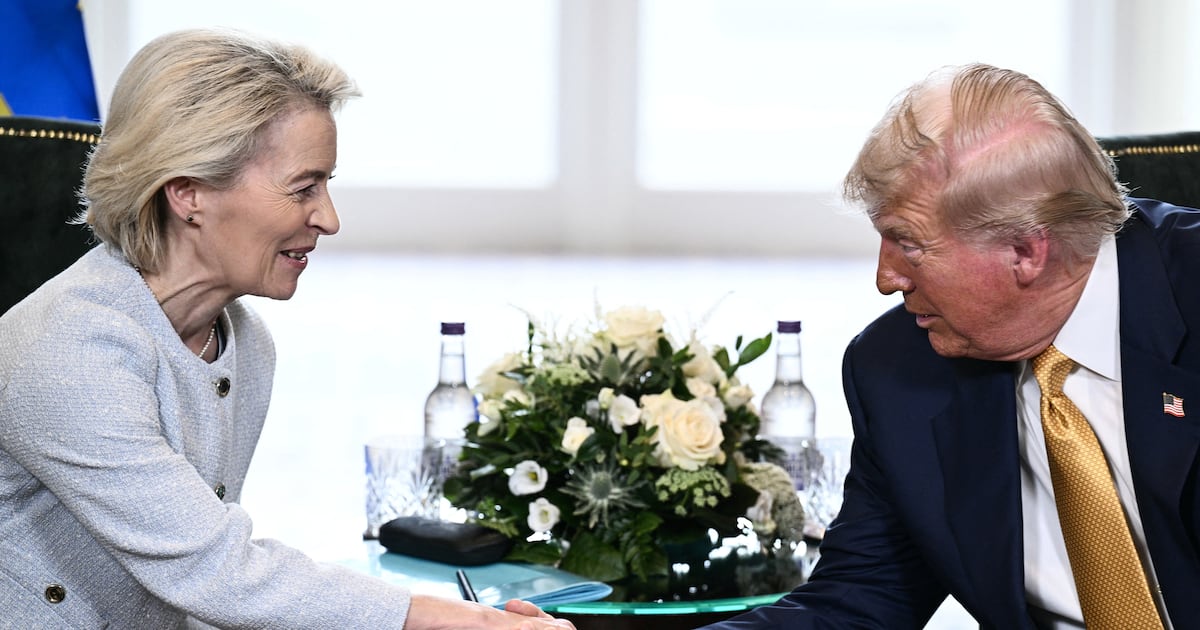World
EU and US Finalize Tariff Agreement, Easing Trade Tensions

The European Union (EU) and the United States (US) have reached a significant tariff agreement aimed at stabilizing trade relations and preventing a potential trade war. Announced on July 1, 2025, the deal will maintain tariffs on most EU imports into the US while setting a framework to avoid escalating tensions that have characterized recent negotiations.
The agreement was finalized during a meeting between EU Commission President Ursula von der Leyen and US President Donald Trump at Trump’s Turnberry golf resort in Scotland. This meeting concluded months of negotiations marked by shifting deadlines and threats of higher tariffs from the Trump administration.
Prior to the discussions, President Trump hinted at potential tariffs on pharmaceuticals, stating, “We have to have them made in the United States… We can’t be in a position where we’re relying on other countries.” His comments suggest that the pharmaceutical sector may not receive the same benefits as other industries included in the agreement.
The negotiations aimed to resolve key sticking points, with Trump emphasizing the need for fairness in trade. He urged the EU to open its market to American agricultural products, including those subject to EU regulations that currently restrict imports of chlorine-washed chicken and hormone-treated beef. “They have to open to American products,” Trump asserted.
While both leaders expressed cautious optimism before the meeting, von der Leyen referred to Trump as a “tough negotiator” and highlighted the importance of reaching an agreement. She stated, “I think the president is right; we have a 50-50 percent chance to strike a deal.”
Negotiators had been working towards a blanket tariff of 15 percent on future trade between the EU and the US. This level of tariff was deemed acceptable by European governments, as it could help alleviate the uncertainty caused by Trump’s threats of significantly higher import levies.
The EU had been preparing for a deal, with the commission briefing ambassadors from its 27 member states on the status of negotiations before the Trump-von der Leyen meeting. Senior officials from both sides engaged in talks, with US Commerce Secretary Howard Lutnick and EU Trade Commissioner Maros Sefcovic participating in discussions leading up to the agreement.
In addition to the tariff deal, the EU has been closely monitoring trade relations with Japan, which recently accepted a similar 15 percent tariff on its products sold to the US. Under the current tariff structure, cars produced in the EU face a 25 percent import duty, while steel and aluminum products incur even higher charges.
Trump has stated that if no agreement is reached, the US will impose a 30 percent tariff on nearly all imports from the EU starting August 1, 2025. In response, the EU has prepared to retaliate with its own 30 percent tariffs on approximately €93 billion worth of US exports.
The EU’s readiness to implement these counter-tariffs reflects its commitment to protecting its economic interests. Furthermore, EU officials, including Commissioner Michael McGrath, have indicated that the bloc is actively expanding its network of international trade agreements. The EU recently concluded deals with several countries, including Mexico and Switzerland, and is in negotiations with India, Thailand, the Philippines, and the UAE.
McGrath described the Trump-von der Leyen meeting as a “significant and decisive moment” in trade relations, expressing hope for a comprehensive settlement on all outstanding trade issues, including pharmaceuticals. He outlined an “ideal scenario” of reaching a “zero-for-zero deal” across various goods, but emphasized that the evolving trade landscape requires adaptability and recognition of new realities.
The EU is also considering invoking its anti-coercion instrument, known as the “big bazooka,” to address potential economic coercion from the US. This measure would allow the EU to restrict the operations of US multinationals within Europe and impose export controls on transatlantic trade.
As the two sides navigate these complex negotiations, hundreds of protesters gathered in cities like Edinburgh and Aberdeen to demonstrate against Trump’s visit, highlighting public sentiment surrounding these high-stakes discussions.
The concluded agreement represents an essential step towards stabilizing transatlantic trade relations, but the potential for future disputes remains. Both the EU and the US will need to monitor the implementation of this deal closely to ensure that it meets the needs of their respective economies and maintains a constructive dialogue moving forward.
-

 Top Stories3 months ago
Top Stories3 months agoTributes Surge for 9-Year-Old Leon Briody After Cancer Battle
-

 Entertainment4 months ago
Entertainment4 months agoAimee Osbourne Joins Family for Emotional Tribute to Ozzy
-

 Politics4 months ago
Politics4 months agoDanny Healy-Rae Considers Complaint After Altercation with Garda
-

 Top Stories4 months ago
Top Stories4 months agoIreland Enjoys Summer Heat as Hurricane Erin Approaches Atlantic
-

 World5 months ago
World5 months agoHawaii Commemorates 80 Years Since Hiroshima Bombing with Ceremony
-

 Top Stories3 months ago
Top Stories3 months agoNewcastle West Woman Patricia Foley Found Safe After Urgent Search
-

 Top Stories5 months ago
Top Stories5 months agoFianna Fáil TDs Urgently Consider Maire Geoghegan-Quinn for Presidency
-

 World5 months ago
World5 months agoCouple Convicted of Murdering Two-Year-Old Grandson in Wales
-

 World5 months ago
World5 months agoGaza Aid Distribution Tragedy: 20 Killed Amid Ongoing Violence
-

 World5 months ago
World5 months agoAristocrat Constance Marten and Partner Convicted of Infant Murder
-

 Top Stories4 months ago
Top Stories4 months agoClimbing Errigal: A Must-Do Summer Adventure in Donegal
-

 Top Stories4 months ago
Top Stories4 months agoHike Donegal’s Errigal Mountain NOW for Unforgettable Summer Views









